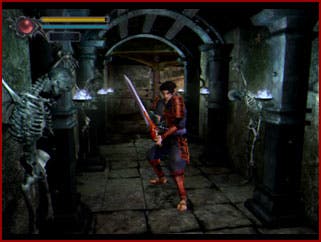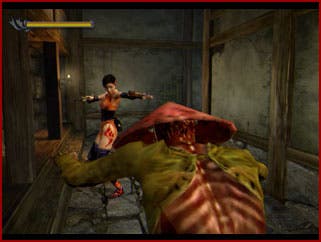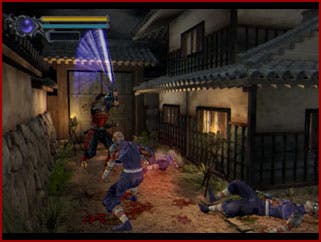Onimusha Warlords
Review - the glitziest introductory sequence ever and a helluva game, but is it long enough?

Who says the PlayStation 2 is boring?
Onimusha Warlords is the second really thrilling PlayStation 2 game we've seen in under a week. The much hyped, long-awaited PS2 exclusive is a triumphant journey through a land of sumptuous visuals and breathtaking computer generated cut-scenes, and really shows what the oft-criticized console is capable of doing under the right direction. It had one of the biggest budgets of any videogame ever, but instead of blowing it on designer clothes and perms, the developers put it to work where it was needed. Apart from the unrivalled visuals, Onimusha boasts a wonderful orchestral soundtrack performed by the New Japan Philharmonic that fits the game like a glove, and a storyline that plunges you right back into feudal Japan without a crutch to lean on. In short, it's a killer app. Capcom are the masters of CG intros. We already know this from their work with the Resident Evil series, but even so, $2 million is quite a lot of money to spend. The reason it cost so much, and works so well though, is that they didn't collect a circle of trainee artists and get them to animate it using 3D Studio Max, they paid an outside consultancy to create a proper introduction, which lasts five minutes in total and overloads you with excitement and intrigue. Instead of the usual clanking swords of unrealistic warriors, the introduction is eerily realistic, with live action armies slicing and dicing one another. It starts with a battle between two warlords and their armies. At the conclusion of the battle, the legendary Nobunaga Oda, who came close to uniting Japan under his banner in real life, is slain by a rival warlord with an arrow to the throat.

Mario meets Tenchu?
The movie also introduces us to the game's hero, Samanosuke Akechi, an incredibly talented swordsman and warrior who fights selflessly to free others. Once he's dealt with some foolhardy aggressors, our hero hotfoots it to the famous Inabayama Castle in the Mino Prefecture, home of the Yoshitatsu Saito, sensing trouble for Saito's beautiful daughter Princess Yuki. His concern proves well-founded, and despite coming close to rescuing her, Samanosuke is left grasping at air, his quest clear. Our only concern up to this point was that you can't skip the CG. Then again, why would you want to? The game is effectively about saving the princess, but there's a lot more to it than that. Princess Yuki is being held by demonic forces under sinister circumstances, their intention being to use her to elevate the undead Nobunaga Oda and his evil master Fortinbras to the control of Japan. Things soon get even racier, with movie style production values retained throughout. With Princess Yuki in trouble, Samanosuke races to her aid, but recognizing his naïvity the mystical Ogre clan draw him into a deep sleep where they give him a magical gauntlet with power over the souls of others. With this, they reason, the lad can't go wrong. The gauntlet can absorb the souls of freshly departed enemies as they float off into the ether, and using the power of once mighty warriors Samanosuke can generate strength and magical attacks to ward off his foes. Joining Samanosuke on his quest is the ninja lovely Kaede, whose moves include silent, gravity defying mid-air throat slices and other tricky attacks. Samanosuke and Kaede complement one another beautifully, with agile movement and contrasting fighting styles.

Luscious
Visually the game and its characters are sublime, with lavish, richly detailed backgrounds and texturing. You fight and move in pre-rendered scenes ala Resident Evil and Dino Crisis, and some of the stills wouldn't look out of place on the wall of an art gallery. One of our only complaints with this pre-rendered approach is that, as with Resident Evil and Dino Crisis, enemies coming around a corner appear from nowhere, and it can be very difficult to fight in the confines of the transition areas, where you only have an awkward overhead view of Samanosuke or Kaede. Another issue is that the backgrounds are so lavish that they take a split-second to load, and if you're fighting a battle and back-tracking into different areas the game stalls for a second shifting between stills, which can be irritating as it breaks your concentration. It can also mess up the controls, especially if your sword is streaking across an enemy's chest as the scene changes. Often it's difficult to recover, or the attack misses in the commotion. The control system is pretty forgiving apart from that though. You use the D-pad to move (which seems more precise in a rather nonsensical way than the analog stick), and your attacks are split between Square (for sword thrusts) and Triangle to perform a special, magical move. When an enemy is killed its soul floats up and you hit Circle so that Samanosuke can absorb it. During battles you can also do cute little 180 degree spins using R2 (as borrowed once again from Resident Evil), and block incoming attacks with L1. During the scant puzzle/adventure sections of the game, the X button performs an action or opens a door.

Vicious
As the balance of controls suggests, Onimusha Warlords is more about fighting than adventuring. This may go against Capcom's Survival Horror heritage, but it makes a nice change, and Samanosuke and Kaede's fighting styles are suitably different and varied that you rarely lose interest. The weapons and combat system are an obvious crowd pleaser in this department. Various upgrades are available for your sword, and your magical repertoire increases are your soul count does. Kaede on the other hand picks up various tactics, and her use of throwing knives is tireless. Oh, and if you've been in a particularly tough fight (and few of them are easy), you can seek some closure from the encounter by driving Samanosuke's sword into the heart of your fallen enemies as they lie prostrate. This is unimaginably satisfying, and if you do buy Onimusha Warlords you will spend at least the first half of the game doing just that. Strangely for such a delicious epic, the game's conclusion is a lot weaker than the rest of it. For anybody who has ever played through a real Japanese RPG (Final Fantasy or Chrono Trigger will do), a proper end sequence sews up all the holes and explains away anything you were uncertain of. Onimusha's just leaves you guessing, with plenty still outstanding at the close. There's obviously some scope for a sequel, but why not make it a little less obvious?
Conclusion
Despite its movie-like production values and incredible opening, Onimusha leaves its audience guessing at the end, and given that it's only 10 hours long (less if you gun through it quickly), it's almost disappointing. I certainly wanted more, but then I completed it in just two sittings. The problem is, once you know the ins and outs there isn't much replay value. It's true, hacking people to bits with swords doesn't grow old, and you can be quite creative with Onimusha, but really you're looking at 10 hours or so of gaping awe, followed by twenty minutes or so of consternation, and a gap of several months before you bother to play through it again. There's some argument that games should be this sort of length anyway, but marketing alone for Onimusha hit $10 million in the States. An ambitious romp through feudal Japan with very few pit stops, and definitely the prettiest game on the PlayStation 2, but it ends sharply. Bear that in mind.



